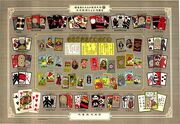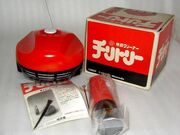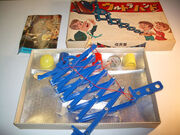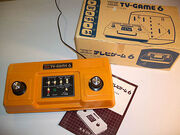
Fusajiro Yamauchi purchased this building which became Nintendo's first headuqarters in 1889.
Nintendo was founded in 1889 by Fusajiro Yamauchi in Kyoto, Japan [1].
Pre-video game industry
1889-1928
The Japanese government had placed a ban on all gambling in Japan, and subsequently cards with numerical symbols on them were taken out of circulation. The government, however, did allow for Hanafuda cards, mostly because they weren't generally associated with gambling and had illustrations in lieu of numbers. Still, by the time Hanafuda had been introduced they had relatively little appeal to the Japanese populace. It could be said that they were expected to run their course just as quickly as they arrived. A man by the name of Fusajiro Yamauchi, however, saw the potential in the market and came up with a plan to re-introduce the game to Japan by crafting hand drawn illustrations on cards made of mulberry tree bark. Consequently he opened up a new company named at the time Nintendo Koppai on September 23, 1889 (Fusajiro was thirty one when he opened up the company).

A poster showing off Nintendo's Hanafuda cards.
The company was based in Kyoto, Japan and had a small building which was deemed the headquarters of Nintendo Koppai (upper right image). In Japan, the name Nintendo is typically translated as "leave luck to heaven", though it is also said to mean "heaven blesses hard work", "in heaven's hands", "work hard, but in the end it's in heaven's hands", or even "The Hall of Entrusting Heaven" (according to the Touch Generations website, the first one is what it officially means).
Nintendo's Hanafuda cards had began to increase in popularity, eventually even being used for gambling which the government had opposed. The Yakuza even began to use Nintendo Koppai's Hanafuda cards. Fusajiro had no choice but to hire more employees so that they could keep up with the demand for his cards. Over the years Nintendo started to manufacture more and more styles of cards, the most popular of which was the Daitouryou, or Napoleon, deck. The Miyako No Hana Hanafuda deck, which was more traditional in style, was also very popular. In 1907 Nintendo Koppai partnered with the Japanese company Japan Tobacco & Salt Corporation (now just Japan Tobacco) which allowed Nintendo to sell their cards in cigarette shops all across Japan. Tei Yamauchi, Fusajiro's daughter, would marry Sekiryo Kaneda in 1907 also. Twenty years later in 1927 Hiroshi Yamauchi, Sekiryo's grandson, was born.
1929-1949
In 1929, Fusajiro Yamauchi retired and deemed his successor to be Sekiryo. However, in order to keep in tradition, Fusajiro adopted Sekiryo, who would then be known as Sekiryo Yamauchi. Three years later in 1932, Hiroshi's father leaves his family and Hiroshi is subsequently sent to live with his grandparents who at the time were in control of Nintendo. A year later a joint venture with another, unknown company was established and Nintendo Koppai was renamed Yamauchi Nintendo & Company. It should also be noted that in 1933 King Kong, which would much later in life prove to be a hindrance on Nintendo, was released in theaters. In January of 1940, Fusajiro Yamauchi died of a stroke during World War II. One year later Gunpei Yokoi would be born.
Sekiryo decided to organize a new company in 1947 whose sole purpose was to manufacture Nintendo's cards (both Hanafuda and other ones that Nintendo had ushered in over the years), and labeled it Marufuku Company, Ltd. Two years later in 1949, Hiroshi Yamauchi, who was young but capable, was named the successor to Sekiryo due to his poor health. Sekiryo has ran the company for twenty years, but it time to pass the torch onto his grandson. As previously mentioned, Sekiryo's son-in-law Shikanojo Inaba, who despite being adopted into the family, did not become president based on the fact that he left his family. His son, however, who was brought up by Sekiryo, would.
1949-1964

The new building in Kyoto, Japan. Today the once-Nintendo headquarters is vacant.
When Hiroshi Yamauchi took control of the company, he renamed it Nintendo Playing Card Co. and Marufuku Company Ltd. to Nintendo Karuta Company, Ltd., and moved his business to a new location in 1952. The same year, a man named Shigeru Miyamoto would be born, who would later become one of the most pivotal employees of Nintendo. Hiroshi in 1959 had met with Walt Disney to strike a deal that allowed Nintendo to place Disney's properties on their cards. This resulted in cards that sported recognizable characters such as Mickey Mouse (years later in 2008, Disney would venture into the Hanafuda business again, though this time with the company Angel). Nintendo chose to partner with Disney in order to gain appeal with Japanese families. During this time he also released books that would explain in great detail how to play the various Hanafuda games. This venture became a great success, as Nintendo sold an estimated 600,000 decks in one year, which prompted Hiroshi to take Nintendo public and introduce it to the Osaka Stock Exchange in 1962. Based on this newfound success, Hiroshi would plan to expand Nintendo more than ever before. Due to a visit to America years prior he had found the limitations the card business had offered, and thus chose to look elsewhere for success while remaining persistent in the card business.

The Chiritory.
The first order of business was to change the name from Nintendo Playing Card Co. to just Nintendo Co., Ltd. in 1963 in order to not be affiliated exclusively with cards. Hiroshi's first venture outside of cards was to manufacture individualized instant rice (attempting to capitalize on the success of instant noodles), which proved to be a catastrophe for Nintendo. Immediately afterwords he opened up a chain of love hotels, which like the instant rice before it did not become a lucrative business choice. The Daiya taxi service was primarily operated by Nintendo and was successful for a shirt while until unions rocketed the salaries upwards, forcing the company to be shut down. Nintendo would later distribute a vacuum cleaner called the Chiritory which would cruise around the floor sucking objects up via a remote control. The Chiritory, like everything else, was not successful. Nintendo had, however, found a favorable outcome with toys. If Nintendo was going to stay alive, they would have to change their business perspective from cards to toys, as the cards business had to an unexpected turn for the worse after the Tokyo Olympics in 1964. Nintendo's stocks dropped from 900 yen to an unfortunate 60 yen. It was time to look towards the more advantageous toy market, and thus in 1964 Nintendo opened up their first research and development branch which they simply named Games. Their first toy they released in Japan was called the Rabbit Coaster [2].
1965-1977

The Ultra Hand was one of Nintendo's earliest successes in the toy business.
In 1969, Nintendo opened up a new manufacturing production plant in Uji City in Kyoto which would be a primary location where Nintendo would develop its toys. Four years prior In 1965, Gunpei Yokoi was hired as an assembly line maintenance engineer. He had just graduated from Doshisha University and was sent to Nintendo to work on the assembly line that manufactured Nintendo's Hanafuda cards which by now had become less successful than they were years prior. He worked there for several years before Hiroshi Yamauchi visited the plant and took notice of an invention Gunpei Yokoi had created for his own personal enjoyment. Yamauchi loved the invention so much that he ordered Yokoi to enhance it and manufacture it before Christmas. Yamauchi, whose company was still deep in dept, had found the invention he was looking for. Called The Ultra Hand, it was an extending arm that could grasp onto things far away. After everything was said and done, the Ultra Hand managed to sell 1.2 million copies across Japan, a phenomenal success for a company who couldn't seem to find a popular toy for kids. The Ultra Hand put Nintendo on the map and proved that they could endure in a market dominated by Bandai and Tomy.
Gunpei's first foray into the toy business would certainly not be his last, and the Ultra Hand could hardly be considered his most impressive invention. In fact, he would soon become one of the most legendary employees in Nintendo's history. Gunpei would continue his Ultra series with the release of a machine that could throw baseballs called the Ultra Machine, and a periscope known as the Ultra Scope. Gunpei Yokoi also invented Nintendo's successful Love Tester which was intended to test a boy and a girls romantic feelings towards each other when they inserted their hands in the machine. Of course the readings weren't accurate, but it was a fun toy that proved popular. Thanks solely to Gunpei Yokoi's inventions, Nintendo was launched to the top of the industry, and things would only progress when Yokoi was sent to a position where he could hire employees. With this newfound power, he chose to hire Masayuki Uemura who had previously worked at the company Sharp in Japan. Together they would develop the Nintendo Beam Gun games. It can be said that this was Nintendo's first quest into the video game market. Today the Beam Gun games are best known as the predecessor to the NES Zapper. In 1973 Gunpei Yokoi would create the Laser Clay Shooting game which would replace various bowling alleys in Japan. In the country, there was a short spur when bowling became an inexpensive pastime, though it shortly ended. Nintendo bought a multitude of these alleys and put Laser Clay Shooting equipment in the bowling alleys' place. A year later in 1974, Nintendo would pursue the rights to market the Magnavox Odyssey in Japan, and did so with great success. This year they also implemented the Beam Gun technology in the game Wild Gunman in arcades. Other light gun games released around this time included Shooting Trainer (1975), Sky Hawk (1976), and Battle Shark (1977). Gunpei Yokoi certainly made a mark on Nintendo's history. He would continue to work with Nintendo for years and would develop a hefty amount of endearing franchises that would stand the test of time. But there was another piece to the puzzle who would come in the form of Shigeru Miyamoto.
Video game beginnings
1977-1979
Nintendo had gotten a taste of electronic video games with devices such as the Love Tester, the Magnavox Odyssey and Laser Clay Shooting, though with Gunpei Yokoi and Shiguer Miyamoto now within the company, things would start to change. And indeed they did. Whereas in 1974 Nintendo distributed the Odyssey in Japan, they would subsequently decide to create their own video game console via a joint venture with Mitsubishi Electric.

The Color TV Game 6.
The games they created were Color TV Game 6 in 1977 and Color TV Game 15 in 1978. The games consisted of various adaptions of the Atari game known as Pong with minor alterations. Both iterations sold over a million copies and further cemented Nintendo's position in the industry. Color TV Game 15 was partly successful for including controllers connected to the console via wires whereas the original had the console and controller connected as one single unit. The same year would find Shigeru Miyamoto's gaming debut with the release of Color TV Racing 112. He didn't work on the actual programing or game design, but instead designed the housing of the system. Miyamoto years later mentioned that he viewed the designs of the first two Color TV Games as "bad" and he wanted to greatly improve on them. For Color TV Racing 112 he included a wheel to make the game more accessible.
Color TV Racing 112 and Color TV Game 15 weren't the only games Nintendo would develop in 1978, however, as this marked the year of their first, non-light gun arcade video game, titled Computer Othello, a computerized version of Reversi. It was a table top single and multiplayer video game that was never released outside of Japan. Also released this year was Test Driver which used a wheel similar to the one found in Color TV Racing 112. In the game you wouldn't race opponents, however, but instead just try and not crash. A Breakout clone named Block Fever was also released in arcades this year, and in 1979 would be remade as a console game and renamed as Color TV Block Kusure. In 1979 Nintendo would start to crank out arcade titles that were typically clones of popular games, though one in particular stood out. Titled Sheriff, the game had the player take the role of a gunman whose goal was to shoot down all of his enemies and save the "damsel in distress". This game was the first time Shigeru Miyamoto worked directly on the design, crafting the characters that were in the title. Other games released during this time include Space Fever, SF-HiSplitter, Monkey Magic and the surprisingly original Space Launcher which predates Frogger by at least two years. Around this time Nintendo's Gunpei Yokoi started dreaming up a new project that was more impressive than anything he had conceived in the past.
1980-
Gunpei Yokoi was once traveling on a bullet train in Japan when he glanced over and saw a man messing around with a portable LCD calculator. The man seemed bored and was just playing around with it to pass the time. This caused Gunpei Yokoi to come up with the idea of a portable LCD video game game, which soon gave birth to the Game & Watch. Game & Watch games did not contain interchangeable cartridges and thus when you bought the game, you bought an entire piece of hardware. The first Game & Watch game released, titled Ball, was distributed throughout the entire world. As surprising as it seems, the release of the Game & Watch was not the most important event in 1980. A man named Minoru Arakawa had went to the United States after graduating from Kyoto University. He learned the in and outs of the country after purchasing a cheap van and going from coast to coast. Upon arriving back in Kyoto, he married Yoko Yamauchi, Hiroshi Yamauchi's daughter. It was then at a diner with his father-in-law when Hiroshi Yamauchi approached Minoru and explained to him that he wanted to open a Nintendo branch in the United States, and offered him the job of president. Yoko desired that her husband stay in Kyoto, though Hiroshi eventually convinced them both to head to America and open up the new branch, and subsequently Minoru, Yoko, and their daughter headed to New York, beginning Nintendo's arrival in the West.
Nintendo's new American branch would distribute Game & Watch games throughout the states. The first batch included the previously mentioned Ball, as well as Flagman, Vermin, Fire and Judge. All of these games were part of the Silver series Game & Watch units, and would soon be succeeded by the Gold series in 1981. By 1980 Nintendo had yet to make themselves a household name due to their arcade titles generally being clones of previously released titles. Both Hiroshi and Minoru wanted to release a game that would prove extremely popular in the United States for Nintendo of America to distribute. Nintendo's R&D division got to work on an arcade title that they titled Radar Scope. When released in Japan, it proved to be lucrative enough to release stateside, though it took too long to arrive and by the time it did, retailers would extremely disappointed by the product Nintendo of America showed them, and they only managed to sell one third of the units they had ordered. Minoru contacted his father in law, explaining the ordeal and asked that they create a game that could replace the unused Radar Scope units, as they didn't have the money to simply make new cabinets. At the time most of the game designers were already hard at work on other products, so Hiroshi turned to an inexperienced new employee named Shigeru Miyamoto, who had been hired based on toys he had presented to Yamauchi. At first Yamauchi wanted Miyamoto to simply remake the game, though Miyamoto thought it would be more appropriate if he started the entire project over. Thus began Donkey Kong.
Yamauchi assigned Gunpei Yokoi to help assist Shigeru Miyamoto in crafting his first masterpiece. He taught Miyamoto all he knew about game design to get him started, but for the most part Miyamoto was left alone to create the game. During the initial stages, Miyamoto had wanted to get the license to create a game based off of the Popeye property, though was unable to receive it. With this he chose to create his own characters. The playable character would come to be known as Jumpman due to his jumping abilities. He'd be up against the villain known as Donkey Kong, who had just escaped from Jumpman's clutches and kidnapped his girlfriend known as Pauline. The game was the first platformer in which the character could jump over obstacles, which generally has caused some to deem it the first platformer. When the game was finally finished, they sent it to America, and the very few employees of the company didn't like what they saw. Rather than have this new genre they wanted Miyamoto to create a game within the maze or shooting genre, but Hiroshi and Minoru assured them that the game would be a success. They later approved but weren't sure about the name of Donkey Kong and Jumpan. Yamauchi allowed them change the name of Jumpman though he refused to budge when it came to Donkey Kong. When trying to come up with a name for the main character, Nintendo of America's landlord went in the room demanding his rent check. His name was Mario. Following this the game was sent to two bars in Washington. By the end of the week the arcades were chalk full of quarters. Needless to say employees of Nintendo of America were shocked to hear this, and immediately ordered replacement chips for the unused Radar Scope units. Nintendo only had five employees at the American branch, and all of them gutted the Radar Scope units and prepared them for Donkey Kong. Yoko, Minoru's wife, was even enlisted to help. Donkey Kong arrived, and by the end of its life cycle it managed to become the second highest selling arcade video game of all time, and to this day retains that record.

